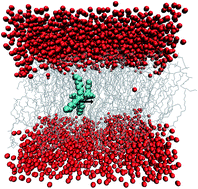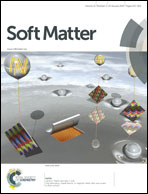From molecular modelling to photophysics of neutral oligo- and polyfluorenes incorporated into phospholipid bilayers†
Abstract
The combination of various experimental techniques with theoretical simulations has allowed elucidation of the mode of incorporation of fluorene based derivatives into phospholipid bilayers. Molecular dynamics (MD) simulations on a fully hydrated 1,2-dimyristoyl-sn-glycero-3-phosphatidylcholine (DMPC) bilayer, with benzene (B), biphenyl (BP), fluorene (F) and tri-(9,9-di-n-octylfluorenyl-2,7-diyl), TF, have provided insights into the topography of these molecules when they are present in the phospholipid bilayer, and suggest marked differences between the behavior of the small molecules and the oligomer. Further information on the interaction of neutral fluorenes within the phospholipid bilayer was obtained by an infrared (IR) spectroscopic study of films of DMPC and of the phospholipid with PFO deuterated specifically on its alkyl chains (DMPC–PFO-d34). This was complemented by measurements of the effect of F, TF and two neutral polymers: polyfluorene poly(9,9-di-n-octylfluorenyl-2,7-diyl), PFO, and poly(9,9-di-n-dodecylfluorenyl-2,7-diyl), PFD, on the phospholipid phase transition temperature using differential scanning calorimetry (DSC). Changes in liposome size upon addition of F and PFO were followed by dynamic light scattering. In addition, the spectroscopic properties of F, TF, PFO and PFD solubilised in DMPC liposomes (absorption, steady-state and time-resolved fluorescence) were compared with those of the same probes in typical organic solvents (chloroform, cyclohexane and ethanol). Combining the insight from MD simulations with the results at the molecular level from the various experimental techniques suggests that while the small molecules have a tendency to be located in the phospholipid head group region, the polymers are incorporated within the lipid bilayers, with the backbone predominantly orthogonal to the phospholipid alkyl chains and with interdigitation of them and the PFO alkyl chains.


 Please wait while we load your content...
Please wait while we load your content...